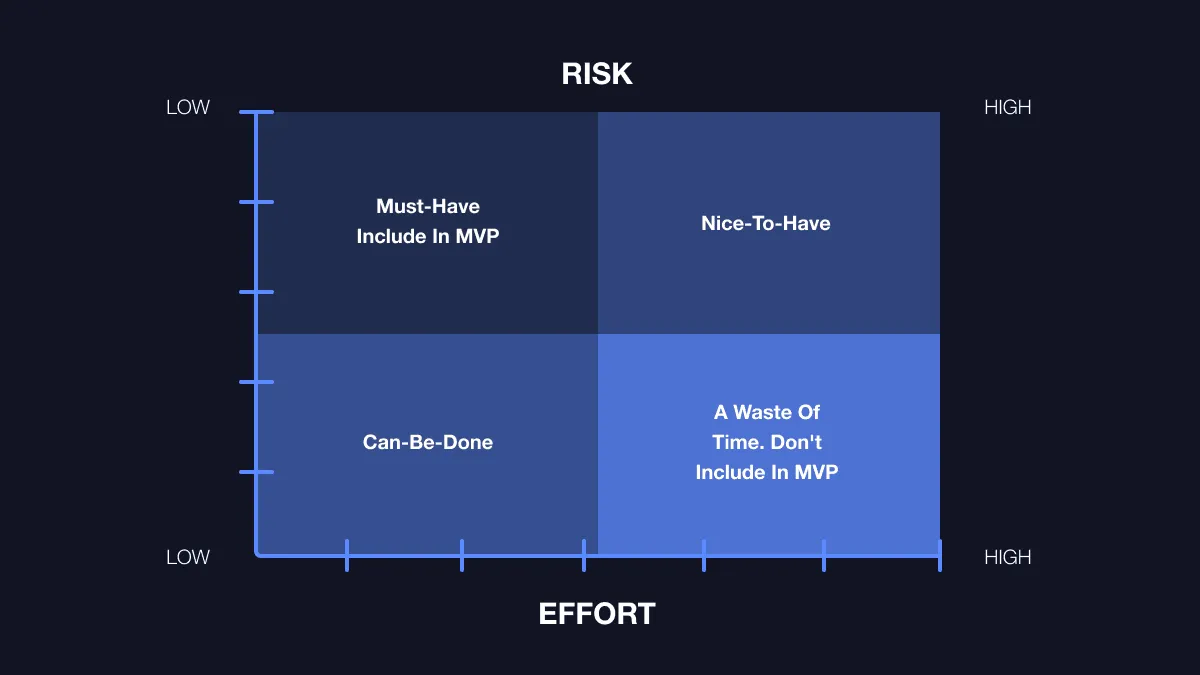EXPLORE
Got a Question? Connect with our experts.
Talk to an Expert
Got a Question? Connect with our experts.
Talk to an Expert
When creating a Minimum Viable Product (MVP), it’s crucial to focus on the core features that enable your initial users to address the problem your app is designed to solve.
What Is MVP Feature Prioritization?
MVP feature prioritization is a process of determining the key features to include in a Minimum Viable Product.
It often involves analyzing similar products and thoughtfully selecting the features necessary to make your initial release successful.
The goal is to achieve this without wasting resources on non-essential features that may evolve in future iterations based on customer feedback.
Feature prioritizing example
"Any customer can have a car painted any color that he wants, so long as it is black.”
said Henry Ford during the introduction of Model T.
When you hear this, you think of limitations. Why restrict your customers to only one color? Why not provide freedom to choose any color?
Henry Ford’s decision was more about simplifying the process.
By focusing on a single, practical option, Ford was able to streamline production, reduce costs, and deliver a product that met the needs of millions.
When you’re building an MVP (Minimum Viable Product), it’s easy to get caught up in adding a lot of features.
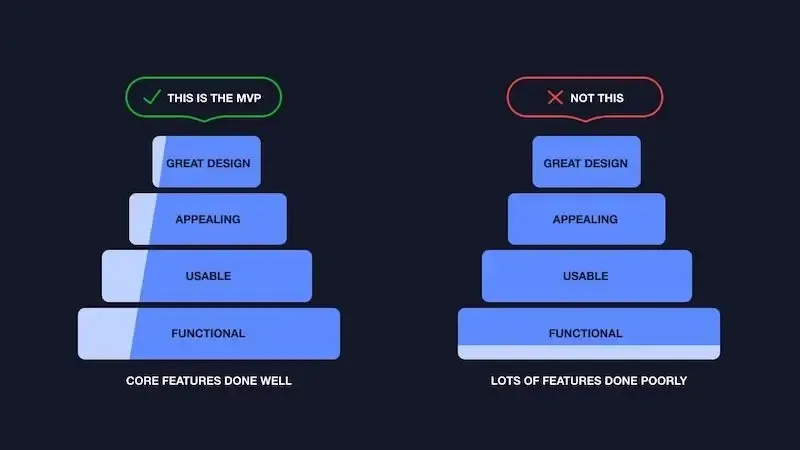
But the truth is, more features don’t always mean more value. In fact, adding too many features can actually slow you down and confuse your users.
In this article, we will walk you through how to effectively prioritize features for your MVP, balancing user needs, business goals, and technical constraints. Let’s dive in.
Why Feature Prioritization Matters for Your MVP?
You want to focus on the features that will solve your users’ core problems, validate your assumptions, and create the most impact with the least effort.
By getting this right, you can:
- Focus on the essential features that prove your product’s value.
- Keep things simple and avoid distractions that will take you off track.
- Spend your time and energy on features that matter, avoiding unnecessary complexity.
- Remember, your MVP isn’t about building a perfect product. It’s about testing your idea, getting feedback, and making sure you’re heading in the right direction.
How to Prioritize Features for Your MVP?
1. Defining Your MVP’s Core Problem and User Persona
The first step in feature prioritization is understanding your MVP’s core objective.
- What is the problem you are solving for your target users?
- Who are your users, and what do they need most?
Create a clear user persona or customer archetype that represents your target audience.

This will help you stay focused on the features that truly align with user needs rather than getting sidetracked by unnecessary functionalities.
2. Listing all Potential Features of your MVP
Start by brainstorming all potential features for your MVP.
This might include functionality you think could add value to your users, ideas your team is excited about, or features that align with your business goals.
At this stage, don’t worry too much about the technical feasibility or priority.
Just get all your ideas down on paper.
3. Evaluating Features against Your MVP’s Goal
Now, evaluate each feature against the goal of your MVP.
Does the feature contribute directly to solving the core problem or validating your hypotheses about the product?
If not, it may be unnecessary for the MVP.
Ask yourself the following questions:
- Does this feature address a critical user pain point?
- Will this feature provide valuable insights into user behavior or product-market fit?
- Can this feature be implemented with the available resources and within the timeline?
If your answer is ‘No’ to the above questions, then you should not prioritize the feature at this point, or save it for future releases.
5 Types of MVP Feature Prioritization Frameworks
There are several prioritization frameworks that can help you rank features based on their impact and effort.
Here are some popular frameworks:
1. RICE Framework
The RICE Framework is a simple way to prioritize features based on four factors: Reach, Impact, Confidence, and Effort.
Each feature gets a score in each of these areas, and you use those scores to calculate a final priority score.
Reach
Reach refers to how many users the feature will impact. For example, if the feature affects a small group, it would score low; if it has the potential to affect a large portion of your user base, it scores high.
Impact
Impact measures how much the feature will improve the user experience, on a scale from 1 to 3. A feature with a large, positive effect would score higher.
Confidence
Confidence is about how certain you are in your estimates for Reach, Impact, and Effort. If you’re very sure, this would score high; if you’re uncertain, it scores low.
Effort
Finally, Effort estimates how much time and resources will be needed to build the feature. This is typically scored from 1 to 10, with lower scores indicating less effort required.
To prioritize, you calculate the RICE score by multiplying Reach, Impact, and Confidence, and then dividing the result by Effort.

This gives you a clear ranking of features, helping you focus on the ones that have the greatest potential to move the needle, but require the least effort to implement.
2. MoSCoW Method
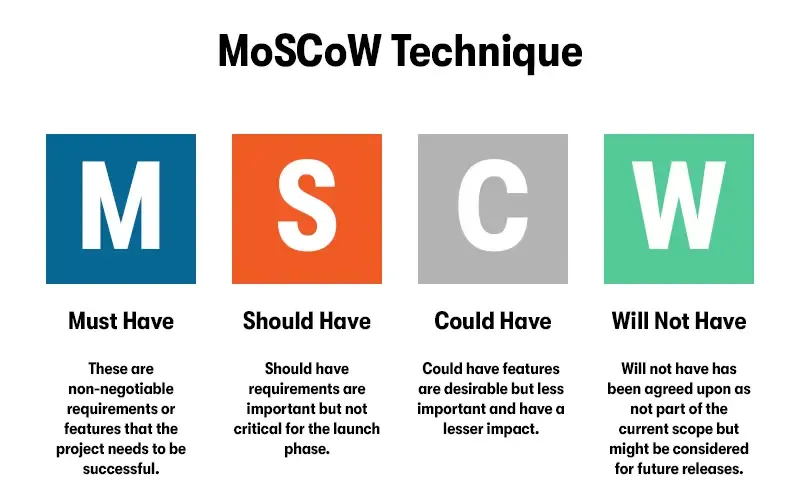
source: Purple Griffon
The MoSCoW Method is a simple technique that categorizes features based on their importance, making it easier to decide what to prioritize for your MVP.
It divides features into four categories:
Must Have
Must-Have features are absolutely critical for your MVP. These are the non-negotiable elements that are necessary for your product to function and deliver its core value. Without them, the product wouldn’t meet the user’s basic needs.
Should Have
Should Have features are important but not essential. They contribute to the overall user experience but aren’t deal-breakers if left out for the initial launch.
Could Have
Could Have features are the nice-to-haves that add extra value but aren’t necessary for the MVP. These can be added later once the more essential features are in place.
Won’t Have
Lastly, Won’t Have (for now) refers to features that are not required for the MVP and can be put off until later iterations. This helps you avoid scope creep and ensures that you’re not spending time and resources on things that aren’t crucial to proving your concept.
By applying the MoSCoW method, you can stay focused on building only the most important features for your MVP, making sure you deliver something functional and valuable without getting distracted by unnecessary additions.
3. The Priority Matrix
The Value vs. Complexity Matrix is a tool that helps you evaluate and prioritize features based on how much value they deliver compared to the complexity of implementing them.
You plot each feature on a two-axis chart, with Value on the vertical axis and Complexity on the horizontal axis.
Features that have high value and low complexity should be prioritized first.
These are the quick wins that will deliver the most impact for the least effort.
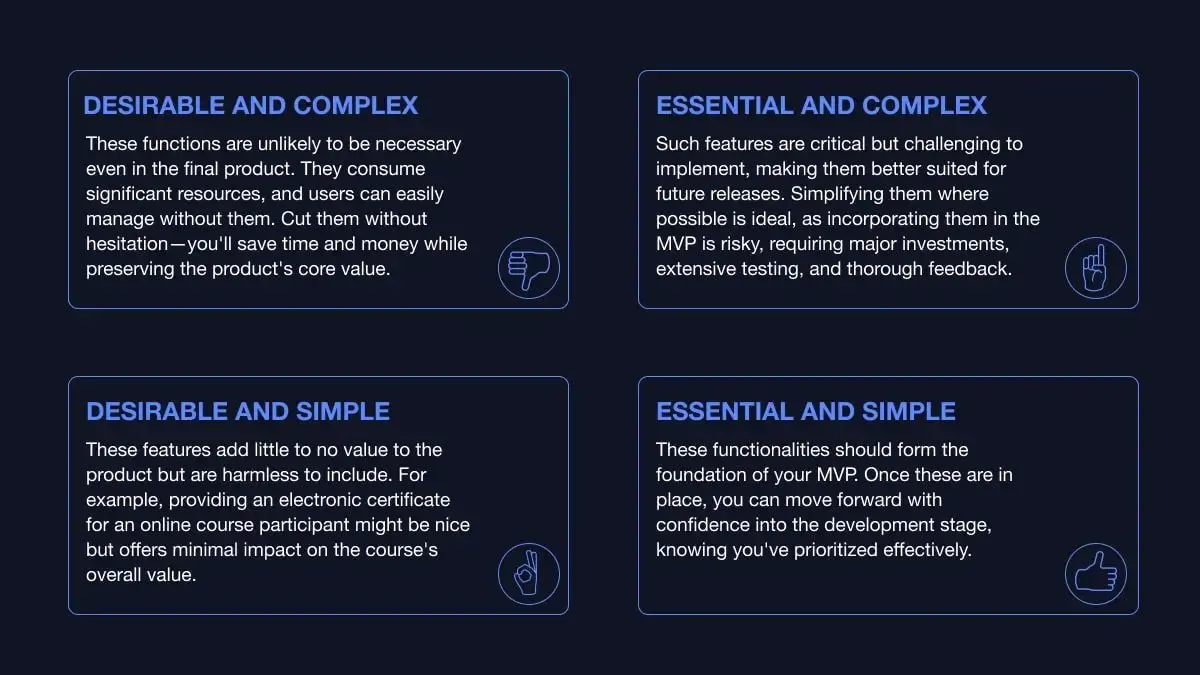
For example, a feature that solves a critical pain point for users and can be implemented easily should be at the top of your list.
On the other hand, features that have low value and high complexity should be deprioritized or removed altogether. These features require a lot of time and resources but don’t add much to the user experience.
Finally, high-value, high-complexity features are important, but they might require more time and resources to build, so it’s better to plan them for future releases, once you have more capacity.
This matrix helps you balance your efforts by focusing on features that are both impactful and easy to implement early on, ensuring you make the best use of your resources.
4. Kano Model
The Kano Model uses feedback from customers as a guide to prioritize features.
It’s really a way to understand how different features can impact user satisfaction.
It’s not just about adding features, it’s about adding the right features that will make a difference to your users.
When thinking about the Kano Model, you can divide features into five categories that show how they impact user satisfaction.
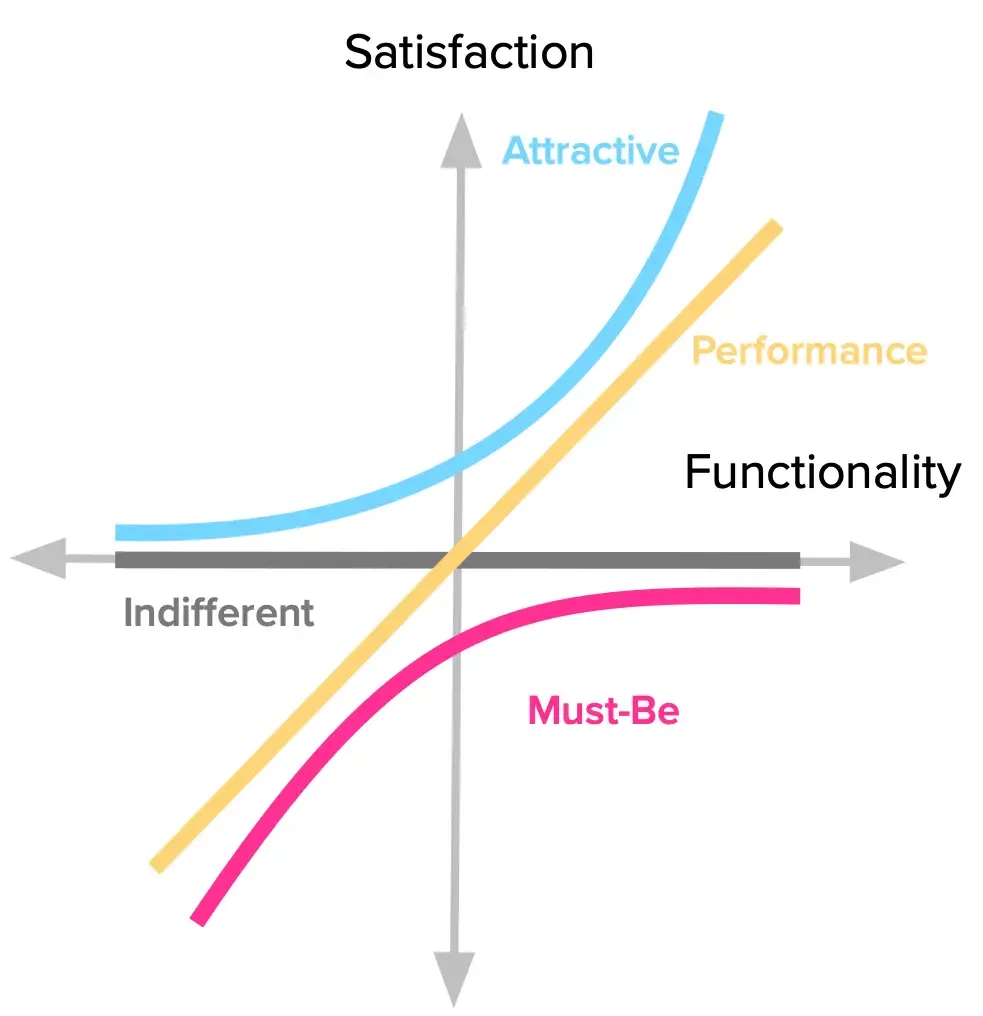
source: Folding Burritos
Basic Needs
First, Basic Needs are the essentials your users expect. If they're missing, users will be dissatisfied. But adding them won’t increase satisfaction much. They are just the minimum requirement to keep users from getting frustrated.
Performance Needs
Performance Needs are features that directly affect user satisfaction. The better these features work, the more satisfied your users will be. Essentially, the more efficiently and effectively these features perform, the more your users will appreciate your product.
Delighters
Delighters are the unexpected features that wow users. They’re not necessary, but when included, they make users feel delighted. If they’re missing, users won’t be disappointed, but they can set your product apart if you include them.
Indifferent features
Then there are Indifferent features, which users don’t really care about. Whether you add them or not, they won’t impact their experience or satisfaction.
Reverse features
Finally, Reverse features actually cause dissatisfaction. These are features that might seem useful but end up frustrating users, such as an overly complicated process or too many notifications.
By mapping features to these categories, you can prioritize the ones that have the greatest potential to improve user satisfaction and differentiate your product.
5. Story Mapping
Story Mapping is a way to organize and prioritize your features based on the user journey. It helps you focus on the big picture and ensure your MVP meets user needs at every stage.
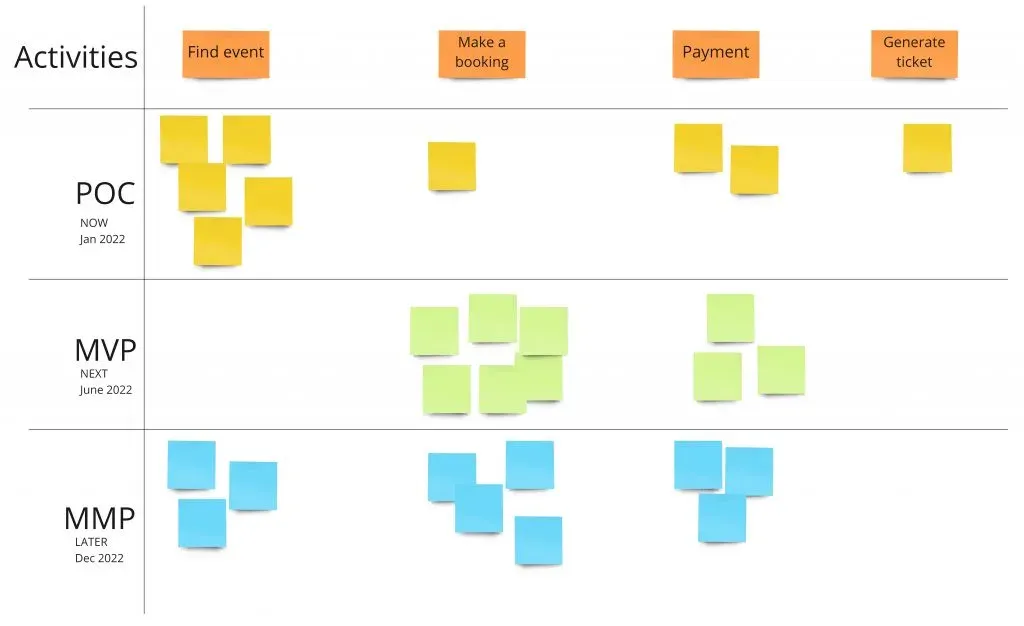
source: Terem
To start, break the user’s journey down into key activities or tasks they need to complete. These are the high-level actions a user takes while interacting with your product.
Next, map out the user stories or features that support each activity. This shows how each feature fits into the overall user experience.
Finally, you prioritize these features by their importance. The core features that are essential for completing key tasks go at the top—these make up the "backbone" of your MVP.
The less critical features, or the "nice-to-haves," can go below and can be added later as you iterate.
Story Mapping ensures that you’re building your MVP in a way that aligns with the user’s needs and the overall business goals.
Considering Technical Constraints and Dependencies
While business and user needs are crucial, it’s also important to evaluate the technical feasibility of each feature.
Some features might be harder to implement than others, or they may depend on other components being built first.
Work closely with your development team to identify any technical challenges or dependencies that may affect the prioritization.
Ensure that you’re not overloading the team with tasks that are difficult or time-consuming, especially in the early stages.
Validating Priorities with Stakeholders
Once you’ve prioritized your features, it’s important to get feedback from key stakeholders. This includes your team, investors, and possibly a small group of users. Share the prioritized list and ask for feedback to ensure alignment on what should be built first.
This validation process can help you catch any blind spots or misalignments before development begins.
Best Practices for MVP Feature Prioritization
Your MVP should deliver the most value with the least amount of work.
Prioritize the features that directly support your core business goals and user needs.
Avoiding feature bloat
Resist the temptation to add too many features, as this can lead to delays and unnecessary complexity. Keep the scope tight.
Iterate based on feedback
Feature prioritization is not a one-time task. After your MVP launch, use user feedback to adjust your priorities for the next iteration.
Don’t be afraid to pivot
If your MVP reveals new insights or challenges, be prepared to pivot your product direction and reprioritize features accordingly.


Have you prioritized features of your MVP?
Calculate the cost of developing an MVP with all those features.
Calculate MVP Costs
Insights From globalsoft's Product Owner Kristian Lasić
"It can be painful process, but a necessary one. Feature prioritization allows clients to really think hard on what they want to deliver in their MVP, and globalsoft helps not only to deliver those features but to explain why we should focus on them"
- Kristian Lasić
Conclusion
Feature prioritization for an MVP is an essential process that directly impacts the success of your product.
By focusing on the features that matter most to your users and aligning them with your business objectives, you can create a solid foundation for future product development.
Remember, your MVP isn’t meant to be perfect.
It’s meant to validate your idea and get feedback.
By carefully selecting the right features, you’ll be able to learn from real users and iterate towards a better product.


